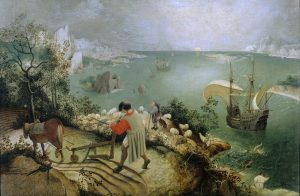Waarom vond ik de mythische verhalen over het kunstenaarschap interessanter dan de kunstwerken die ik heb gezien? Dat vroeg ik me af na het bezoek aan de expositie GOED GEMAAKT (ode aan het maakproces) in de Amersfoortse kunsthal KAdE.
Slechts door een enkel kunstwerk werd ik geraakt, terwijl de verhalen over Daedelus, Pygmalion en de dochter van Butades me mateloos fascineerden.
Vliegen
Daedelus was een beroemd architect en uitvinder die samen met zijn zoon Icarus van de Kretenzer koning Minos de opdracht kreeg op Kreta een labyrint te bouwen. Helaas raakten de verhoudingen verstoord en kwamen de twee op het eiland vast te zitten. Maar niet getreurd: vader en zoon bouwden van een houten staketsel twee enorme vleugels om te ontsnappen. Ze gebruikten was om de vleugels te bekleden met veren.

Het vervolg zal u bekend zijn. Bevangen door enthousiasme vliegt Icarus richting de zon, zodat de was smelt en hij te pletter valt. Wie te hoog grijpt, kan een flinke smak maken
Op de expositie wordt een verband gelegd met de Nederlandse kunstenaar Joost Conijn (Nederland, 1971). Hij bouwt een vliegtuig en rijdt naar de Marokkaanse woestijn, omdat daar nog genoeg ruimte is voor een vliegreis. Helaas gaat er onderweg en in de woestijn van alles mis. Maar ter geruststelling: met Conijn loopt het niet zo af als met Icarus.
Licht en schaduw
De tentoonstelling besteedt ook aandacht aan Kora, de dochter van de Korintische pottenbakker Butades. Als haar minnaar op reis gaat, ‘tekent’ Kora met de schaduw van kaarsen de omtrek van zijn gezicht op de muur. Haar vader vult de contouren met klei. Uit schaduw is reliëf geboren.
Licht en schaduw: niet meer weg te denken uit de kunst. Van de versieringen op Griekse vazen tot de verloren schaduw van Peter Pan. Weet u het nog? De schaduw van Peter wordt aan zijn voet vastgenaaid, zodat hij hem niet weer kwijt kan raken.
Het verhaal van de dochter van Butades wordt een geliefd onderwerp voor kunstenaars. Het spel met licht en schaduw om de werkelijkheid na te bootsen staat later aan de basis van de camera obscura, toverlantaarn, fotografie en uiteindelijk zelfs de (stomme) film.
Persoonlijk vind ik het oorspronkelijke thema veel interessanter. Kunst als een poging om het vergankelijke te vereeuwigen. Het mooiste en kostbaarste (het gezicht van de minnaar van Kora) te redden uit de vluchtigheid van de tijd (de schaduw op de muur).
Tot leven wekken
En dan is er nog de Griekse beeldhouwer Pygmalion. Die was zo teleurgesteld in de vrouwen die hij kende, dat hij uit ivoor zijn ideale vrouw sneed. Natuurlijk wordt hij tot over zijn oren verliefd op haar. Venus – de godin van de liefde – verlost hem uit het lijden en wekt het beeld tot leven. Het koele ivoor voelt ineens warm en zacht aan, het beeld verandert in een vrouw van vrees en bloed. Galanthea slaat haar ogen open, bloost (later een veel gebruikt thema in de kunstgeschiedenis) en beantwoordt de kus van haar maker.
De mythe van Pygmalion illustreert het vakmanschap van kunstenaars om hun materiaal te bewerken en veranderen. Helaas niet altijd met het beoogde resultaat, zoals de prachtige foto van Zohar Gotesman laat zien. Liggend omarmt hij een koud wit beeld, in de hoop dat het tot leven zal komen. Zijn pogingen zijn tevergeefs, dat is zelfs op de foto te zien. Het beeld wil niets van hem weten. De kloof tussen leven en dood wordt niet gedicht.
Aan het werk
Wat mij betreft had de expositie daarna afgelopen mogen zijn. Zonder veel belangstelling banjerde ik door de volgende ruimten. Thema’s als ‘is het kopiëren van kunst ook kunst?’ en ‘wanneer is een kunstwerk eigenlijk af?’ konden me blijkbaar maar matig interesseren.
Hetzelfde gold voor de benedenruimte van de expositie, waar de nadruk ligt op de kunstenaar aan het werk. Negen hedendaagse Nederlandse kunstenaars tonen hun werk en vertellen over het werkproces. En een installatie van Patty Struik (Nederland, 1962) verbeeldt de inspiratiefase: het denken in beelden, het vrije associëren, dromen en verbinden. Beelden die elkaar razendsnel opvolgen en allemaal op de een of andere manier met elkaar te maken hebben.
Verbeelding
Waarna ik me bij de uitgang de vraag stelde waar ik dit artikel mee begon. Waarom fascineerden die mythische verhalen me zo. Het antwoord: ze inspireerden en zetten m’n verbeelding aan het werk. Wat de kunst op de tentoonstelling niet deed, op de foto van Zohar Gotesman na.
Terwijl de kunstenaars op hun beurt wel weer werden geïnspireerd door dezelfde mythische verhalen.
Dit raakt aan de vraag waarom kunst iemand ‘pakt’. Waarom het ene schilderij of beeldhouwwerk je ontroert, terwijl het andere je koud laat.
Laat ik bij gebrek aan een antwoord hierop dit voorlopig maar het raadsel van de kunst noemen.
Zondag 26 maart geven kunstenaars uitleg over hun werk. Elke zondag om 13.00 uur zijn er rondleidingen. De tentoonstelling duurt t/m 17 april (tweede paasdag). Museumkaart geldig. Meer info: http://www.kunsthalkade.nl/
